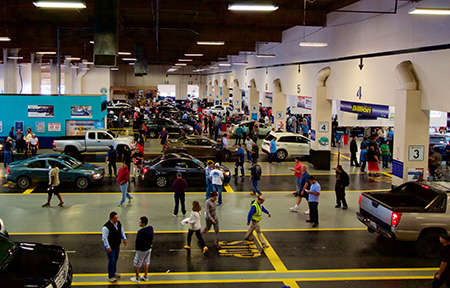No more second-hand innovation
 The conservation of time and the acceleration of goods in the supply chain have long been valued by OEMs and their partners in bringing new cars from production to market. Those principles are increasingly being brought to bear in the used car market, too, with tighter logistics chains and greater deployment of technology used to support a wide set of options for the sector.
The conservation of time and the acceleration of goods in the supply chain have long been valued by OEMs and their partners in bringing new cars from production to market. Those principles are increasingly being brought to bear in the used car market, too, with tighter logistics chains and greater deployment of technology used to support a wide set of options for the sector.
This new emphasis on velocity, which is gaining strength in operations across used markets in the US and UK, calls for a reduction in the time between the last mile driven by the old owner and an initial test drive by a prospective new one. That is now critical to maximising the profit derived from second-hand vehicles.
“There is decidedly more wasted time in the remarketed supply chain than in the new vehicle outbound supply chain – partially because there are fewer full truckloads. There are also fewer dedicated routes, and forecasting of demand is much less sophisticated,” observes Kathleen McCann, chief executive of Michigan-based United Road, one of the US’ biggest car haulers. “There are a number of challenges today, but these challenges are laced with opportunity, as usual.
“From a car hauler’s perspective, I always try to remind those shipping or receiving remarketed vehicles that the most important thing they can do is ensure operational clarity and preparedness,” she adds.
John Stocker, the commercial director overseeing finished vehicle logistics at Gefco in the UK, notes that the traditional car processing scenario can easily involve a four-day wait for an estimator to turn up and then submit a report on the vehicle. The process then involves submitting the estimate to the company and the ultimate decision on whether or not to refurbish the car might then sit in a stack or electronic file with other evaluated vehicles awaiting the final word.
 "There is decidedly more wasted time in the remarketed supply chain than in the new vehicle outbound supply chain... there are fewer full truckloads... fewer dedicated routes, and forecasting of demand is much less sophisticated." - Kathleen McCann, United Road
"There is decidedly more wasted time in the remarketed supply chain than in the new vehicle outbound supply chain... there are fewer full truckloads... fewer dedicated routes, and forecasting of demand is much less sophisticated." - Kathleen McCann, United Road
“It could take up to ten days before the decision is made to start the work on the vehicle,” says Stocker. “Now that ten days is costing somebody; the depreciation doesn’t stop.”
While it has long been the case that the depreciation on a new car begins the minute it is driven off the dealer’s lot, the growth in vehicle leasing in the US, and of personal contract purchases (PCPs) in the UK, has given car owners a safety valve. Rather than concerning themselves with the value of a vehicle at trade-in, like traditional car owners, lease and PCP holders can construct deals whereby they simply hand over their vehicles at the end of the term and enter into a fresh agreement that places them behind the wheel of a new car.
However, the turnover rate after a lease or PCP places urgency on those tasked to get vehicles into resale for a second life. “As soon as that customer hands over that car, it’s now on somebody else’s books – either the financing company or the leasing company – and it is depreciating,” says Stocker. “So one of the hot buttons for our customers is time. People are taking more appreciation today of time and we have placed a lot of focus on how we can improve that turnaround time.”
The US market is also increasingly acknowledging the value of velocity, especially when it is coupled with strategic positioning of used vehicles in locations that provide a high level of demand and maximum profitability.
Kathleen McCann suggests those in the resale market are beginning to make transport decisions based on an overall look at costs and benefits, breaking away from the old-school thought process that has long been based on just rate per mile.
“Smart shippers are focusing on velocity,” she says. “They are recognising that turning inventories and making sales is ultimately more profitable than negotiating a bargain on transportation. Letting the inventory sit while they wait to attract a carrier just doesn’t make sense. If the vehicle isn’t where it needs to be when it needs to be there, it may not sell.”
Rather than simply considering rate per mile, resellers are now considering overall cost and benefits, including velocity, when making transport decisions

Charlie Chesbrough, who recently joined Cox Automotive in Detroit as a senior economist and director of industry insights, and previously served as the chief economist for the Original Equipment Supplier Association, agrees with McCann’s assessment of the role logistics can play in leveraging resale opportunities in the second-life market.
“It’s not the same auction price everywhere, and we are seeing quite a bit of variation. Many dealers are weighing all the costs,” says Chesbrough. “We are seeing significant price variations across the country. Many dealers are taking advantage of vehicles being in oversupply in certain parts of the country and undersupply in other parts.”
Impact of leasesTo see why second-life vehicles are more effectively competing in the overall car market and leveraging a growing number of lease and PCP returns, look at sales trends in the new car sector. While Chesbrough concedes that new car sales are likely to have peaked last year, he puts some context on what is effectively a decline of just a couple of percentage points.
“It’s probably safe ground to say that we are post-peak. But that’s not to imply that it’s a bad market,” he comments. “It’s like saying The Godfather II isn’t as good as The Godfather – but it’s still a pretty good movie,” he adds. “If you look at just retail sales and take out the fleet component, sales are down just one or two percentage points. On the whole, we are still looking at a market that is going to finish as probably one of the top five years of all time.”
The used car market, according to the most recent data compiled by Cox, has been on the rise as well. Chesbrough credits the popularity of leasing programmes as a primary factor, noting that lease vehicles re-entering the market are offering consumers low-mileage, high-quality vehicles that are a worthy competitor to new vehicles.
“I think that it can be a strong headwind for new vehicle sales,” says Chesbrough. “However, the industry has been very aggressive in changing the cadence of vehicles – by putting more updates and making more refreshes on vehicles than in the past. It used to be ‘let’s design a vehicle and we’ll sell it for the next five years’. Now they want to keep it fresh because there is so much competition out there. If I’m in the market to get the latest and greatest in terms of the technology, the new market will always be ahead of the used market.”
[mpu_ad]Many sedans and other cars, as opposed to SUVs, are also available on the used market. As fuel prices rose to historic levels in 2008 and then slowly declined, US consumers moved away from SUVs and larger vehicles in favour of smaller, more fuel-efficient ones – a lot of which are on the used car market, especially as new vehicle sales have swung back towards larger vehicles.
“One of the bigger challenges in the market right now would be the vehicles that are available. What we know from the new vehicle market is that consumers want SUVs. They want crossovers,” comments Chesbrough. “Demand for mid-sized cars is substantially lower than it was just three or four years ago.
“When we look at our Manheim Auction data, we can see that used values for trucks and SUVs remain quite strong and stable. But used values for mid-sized cars are declining on a year-over-year basis. We are starting to see lack of demand on these used cars – and that’s having an impact on their value.”
Generating new approachesPresented with such cost-efficiency opportunities, and given the competitive pressure to quickly move second-life inventories into particular markets before they depreciate too much, automotive logistics professionals are re-imagining supply chain processes and applying technology to generate new approaches.
Gefco, for example, has accelerated the turnaround of vehicles entering the second-life market by employing an inspect-and-collect strategy, says Stocker. Gefco staff are now able to gather data by using a tablet or smartphone at the time of initially collecting the vehicle. This onsite vehicle triage can then be fed into the external system at one of Gefco’s refurbishment facilities. By the time the vehicle reaches the facility, a cost-benefit analysis decision can be made on whether or not to refurbish it for the used car market.
“There used to be a standard for a used vehicle. Whatever the condition of the vehicle, however it came back, you had to get it to that standard. You could end up spending hundreds of pounds and you would not get the return,” says Stocker. “Today, what we see is a smarter programme. We can say to our customer: ‘spend that money because we’ll get a return’. Conversely, we can look at a car and know that they shouldn’t spend a penny on it because they wouldn’t get it back.”
 "If you look at just retail sales and take out the fleet component, sales are down just one or two percentage points. On the whole, we are still looking at a market that is going to finish as probably one of the top five years of all time." - Charlie Chesborough, Cox Automotive
"If you look at just retail sales and take out the fleet component, sales are down just one or two percentage points. On the whole, we are still looking at a market that is going to finish as probably one of the top five years of all time." - Charlie Chesborough, Cox Automotive
The growing strength of the second-life market in the UK is partly reflected in the fact that Gefco now operates four refurbishment centres around the country and moves more than 500,000 vehicles a year. While some of those moves involve new vehicles, the majority of that capacity comes from Gefco’s work with fleet operators and rental companies. The consistency of volume that comes from the fleet and rental sectors – along with its processing centres – allows Gefco to avoid the peaks and troughs found in more traditional vehicle sales cycles.
“We are sitting down with our customers throughout the year to look at what their new car forecasts look like. What vehicles are they planning to place into rental? What vehicles are they planning to de-fleet? This allows us to structure our resources,” says Stocker. “At the moment, we are seeing really healthy growth in the used vehicle market. The used market in the UK is performing better than the new market at the moment. We are seeing good volumes and the prices are holding. Dealers are still looking for enough used vehicles to achieve their sales targets. Demand seems healthy.”
Nigel Glenn, managing director of BCA Automotive, the UK-based car auction and vehicle logistics provider, also sees a strong second-life vehicle market in the UK. In overseeing the BCA fleet of 830 trucks working in the area of automotive transport, Glenn deploys assets that can effectively address the needs of the new car market as well as those of the daily rental, fleet and auction markets.
“The changes that we have been making as a business are an effort to pull all of those elements together to create a better synergy between the fleets,” notes Glenn.
“While the fleets have a primary aim, we also have a very clear communications strategy, and it runs through the same management structure. We look at those fleets closely every day, and we flex the fleets around between the areas. We blur the lines between them,” he continues.
 Gefco operates four refurbishment centres in the UK with the majority of the 500,000 vehicles it moves each year coming from fleet operators and rental companies
Gefco operates four refurbishment centres in the UK with the majority of the 500,000 vehicles it moves each year coming from fleet operators and rental companies“We’re now seeing a lot more movement of vehicles as they move into their second and third lives. Along with the greater volume of vehicles moving, you try to integrate that with the flow of vehicles coming out of daily rental.”
Kathleen McCann says the growing willingness of dealers in the US to transport used vehicles to within easy reach of purchasers can only serve as a boost to those using web-based shopping platforms.
“Internet sales have clearly been impacting vehicle moves,” she says. “It used to be that remarketed vehicles were only purchased at your friendly neighbourhood car dealer – now, as consumers shop online, they can have the car shipped to them. It’s possible for dealers to find the car in their own group inventory, or otherwise from finance company inventories. Then, they bring the car to a local sales point.”
At the moment, single-unit purchases can be tough to move long distances unless the economics line up, she says, but the changes taking place in the American second-life car market promise to continue. Looking ahead, McCann says: “This is an evolutionary versus a revolutionary change in the market and consumers, sellers and transporters are adapting to new options to various extents. There will continue to be winners and losers, for sure. Using technology to the full without losing the human touch will be key to survival.”
In the UK, Gefco’s Stocker also sees market forces driving significant change within the second-life car market. Considering the infrastructure that is in place with refurbishment centres, he can envision a time when pre-evaluated vehicles are not only prepared to re-enter the second-hand market there, but when these facilities – supported by an online shopping experience, complete with virtual tours – serve as the physical point of resale.
“With consumers buying cars on the internet, we are beginning to ask if they need to go to a showroom to collect the car, or [whether you] can have out-of-town handover centres with multiple brands of cars,” he comments. “This would be a way of driving efficiency.
“If you follow that concept, you can improve your logistics by having out-of-city handover sites where multiple vehicle brands are delivered and collected by consumers,” continues Stocker.
 Used values for trucks and SUVs are currently fairly stable in the US, however demographic shifts may change the entire shape of the future second-life vehicle market
Used values for trucks and SUVs are currently fairly stable in the US, however demographic shifts may change the entire shape of the future second-life vehicle market“They could trade over their old cars and then collect their next cars. This would give you much more efficiency by hubbing those vehicles – instead of seeing the smaller quantities coming from multiple locations.”
Though not on the immediate horizon, Stocker’s view of the future within the second-life vehicle market takes into account the millennial generation’s growing influence. That includes viewing vehicles more as a simple means of transport than as a prized possession or status symbol.
“I see this as more of a probability. We are waiting for what I call a ‘Berlin Wall moment’. Somebody will take the step,” he says about the potential for revolutionising the second-life vehicle market into an internet-based, one-stop shop with strategic central locations.
“When I look at the strength of those sociological and market forces, you have to say there is a high probability that the traditional mechanism will in some form change,” he concludes. “It has to change because it’s not going to meet the future needs of those sociological market forces in the way that it sits today,” he concludes.
 "The used market in the UK is performing better than the new market at the moment. We are seeing good volumes and the prices are holding. Dealers are still looking for enough used vehicles to achieve their sales targets." - John Stocker, Gefco
"The used market in the UK is performing better than the new market at the moment. We are seeing good volumes and the prices are holding. Dealers are still looking for enough used vehicles to achieve their sales targets." - John Stocker, Gefco





